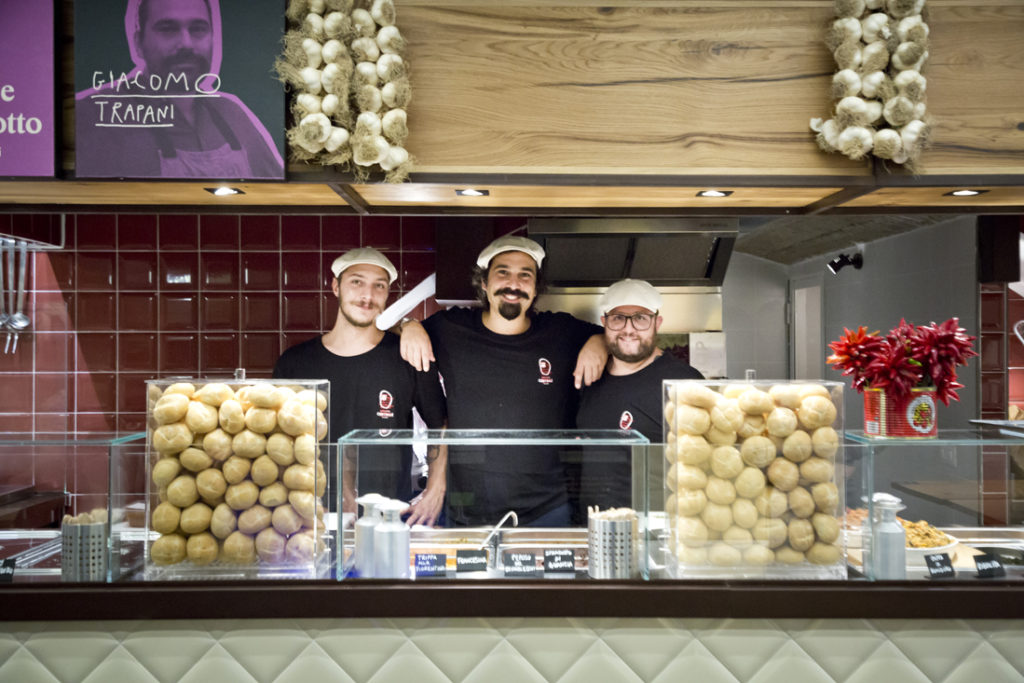
bollito and lampredotto by Giacomo Trapani
Bollito and Lampredotto: Florentine to the core
Giacomo Trapani’s workshop at the Mercato Centrale Milano is home to tradition, quality and what it means to be Florentine.
Ever since the mid-nineteenth century, the Bambi family has practised a tradition that whole generations of Florence’s San Frediano district have grown up with.
The absolutely unmissable dish in this workshop is, without a doubt, lampredotto. Made from the abomasum (the fourth stomach of the cow), and boiled in a broth of celery, carrots, onions and tomatoes, the classic version is eaten in a rosetta bread bun – sprinkled with salt, pepper, spicy sauce and salsa verde – or just from a carton. Then there’s trippa alla Fiorentina, prepared to a jealously guarded recipe that has been handed down through five generations. There’s bollito stew, known locally as i’ lesso; a pork-cheek stew called stracotto di guancia; there’s the peppery, beefy peposo, bruschetta, and the two bready Tuscan soups, ribollita and pappa al pomodoro. Good old-fashioned recipes made within the walls of a Florentine home, using traditional, strictly Italian ingredients.
The absolutely unmissable dish in this workshop is, without a doubt, lampredotto. Made from the abomasum (the fourth stomach of the cow), and boiled in a broth of celery, carrots, onions and tomatoes, the classic version is eaten in a rosetta bread bun – sprinkled with salt, pepper, spicy sauce and salsa verde – or just from a carton. Then there’s trippa alla Fiorentina, prepared to a jealously guarded recipe that has been handed down through five generations. There’s bollito stew, known locally as i’ lesso; a pork-cheek stew called stracotto di guancia; there’s the peppery, beefy peposo, bruschetta, and the two bready Tuscan soups, ribollita and pappa al pomodoro. Good old-fashioned recipes made within the walls of a Florentine home, using traditional, strictly Italian ingredients.
Here, Florentine street food just tastes that much better.
find out more...
Ever since the mid-nineteenth century, the Bambi family has practised a tradition that whole generations of Florence’s San Frediano district have grown up with.
The absolutely unmissable dish in this workshop is, without a doubt, lampredotto. Made from the abomasum (the fourth stomach of the cow), and boiled in a broth of celery, carrots, onions and tomatoes, the classic version is eaten in a rosetta bread bun – sprinkled with salt, pepper, spicy sauce and salsa verde – or just from a carton. Then there’s trippa alla Fiorentina, prepared to a jealously guarded recipe that has been handed down through five generations. There’s bollito stew, known locally as i’ lesso; a pork-cheek stew called stracotto di guancia; there’s the peppery, beefy peposo, bruschetta, and the two bready Tuscan soups, ribollita and pappa al pomodoro. Good old-fashioned recipes made within the walls of a Florentine home, using traditional, strictly Italian ingredients.
The absolutely unmissable dish in this workshop is, without a doubt, lampredotto. Made from the abomasum (the fourth stomach of the cow), and boiled in a broth of celery, carrots, onions and tomatoes, the classic version is eaten in a rosetta bread bun – sprinkled with salt, pepper, spicy sauce and salsa verde – or just from a carton. Then there’s trippa alla Fiorentina, prepared to a jealously guarded recipe that has been handed down through five generations. There’s bollito stew, known locally as i’ lesso; a pork-cheek stew called stracotto di guancia; there’s the peppery, beefy peposo, bruschetta, and the two bready Tuscan soups, ribollita and pappa al pomodoro. Good old-fashioned recipes made within the walls of a Florentine home, using traditional, strictly Italian ingredients.
Here, Florentine street food just tastes that much better.




















